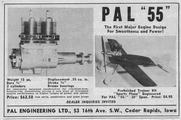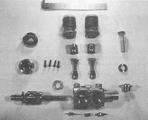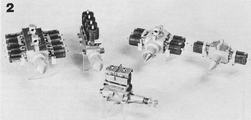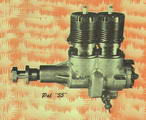|
|
On page 44 of the March, 1950 Model Airplane News the first advertisement for one of the most unattainable model airplane engines of the post war period appeared, the PAL 55 from PAL ENGINEERING LTD., 53 16th Ave. S.W., Cedar Rapids, Iowa. Many questions were raised by the advertisement as in succeeding years it could never be purchased by mail. Apparently dealer inquiries (if any at the price of $62.50) were non existent. The subsequent engine/manufacturer history is most interesting. The comments made in the ad "The First Major Engine Design For Smoothness and Power!" and in smaller print, "An inherently balanced construction for vibration-free, turbine-like smoothness giving a new kind of miniature engine performance in higher ranges of power and speed." were the most hyped up of any ad previous to the ill fated run of modern Fitzpatrick engines. And the "prefinished Trainer Kit sports plane Engineered for the PAL 55" with 30" wingspan and obviously a U-Control type appeared to be much too fragile to handle the large engine.
At the time, then MECA Coordinator, Dick Dwyer intrigued by the engine planned a visit to the factory and there met Mr. Paul A. Lebeda (PAL) and initiated a serious attempt through MECA to secure enough members who wished an engine to give Mr. Lebeda an order for production. Dick reported .. back to MECA in Bulletin #39, Mar-Apr. 1972 with pictures of Mr. Lebeda, his fine prototype engines, the small trainer airplane, confident of getting the manufacturing process under way. Dick noted that a forthcoming article in the Engine Collector's Journal would be much more complete. And indeed it was. Issue #41, Mar-Apr, 1972 Dick wrote the definitive article on the PAL 55 engine. I paraphrase from that article. It seems that Paul A. Lebeda founded and still owned PAL Engineering, Ltd., which was a very fine, well equipped engineering and machine shop there in Cedar Rapids, Iowa. His years of previous experience with Hydroplanes and racing boats on the lakes of the midwest was considerable. He had even invented a unique automobile carburetor. Mr. Lebeda told Dick that his interest in manufacturing a better model engine had stemmed from around 1937, experimenting with many of the motors on the market at that time, until 1944 when the PAL 55 became a reality. An initial production run of 50 engine castings and parts were made, the first 10 being experimental. A few of those were sold. The regular production engines were to have serial numbers beginning with 1000 but for whatever reasons not more than 10 of those were sold.
Utilizing the many years of Mr. Lebeda's engineering skills with full size engines such "innovations" as a one piece crankshaft with internal dual ported rotary valve, a venturi type carburetor, a needle valve design that causes the fuel to be released into the air mixture in molecular form for better induction and more complete combustion, a narrow sleeve bearing under lightly loaded conditions, running with almost the same amount of friction as ball bearings, are a few of the ideas incorporated in the PAL 55 engine. (One has to ask, why the 55 displacement and why an inline twin as a first production model, notorious for cooling well.) The engine's carb was on the underside, the timer assembly in the rear, and the exhaust a "hang on" type like the Barker 60 Manulmatic. A laboriously designed "metal cylinder cowling," necessary for the cooling of the cylinders is pictured on the front engine in the group picture below. That picture also shows the hang on metal exhaust stack for both cylinders.
At the conclusion of Dick Dwyer's article he quotes Mr. Lebeda as saying, "if enough firm orders should be received for engines, I would plan on manufacturing the two-cylinder (PAL 55) as well as additional 2s and 4s ... to keep cost down a minimum production of 500 engines should be achieved." Dick goes on to say as soon as 300 firm orders are received (from MECA members of course) we will negotiate price with Mr. Lebeda. Estimated costs for the PAL 55 were $125-150 and $150-200 for the four cylinder models. Remember this was the spring of 1972. Well, it never happened, and "Iowa" was never heard from again. But incredible as it was, seven years later in the "What's New" column of MAN, August 1979, under "MULTI CYLINDER ENGINES" Paul Lebeda again had his neat engines brought to public attention by giving a brief history and then noting "prices will prevail at the time of delivery." And a new address of PAL Engineering, Ltd., 614 First St., SW, Cedar Rapids, Iowa 52404. No other ads since that time have appeared. All was quiet once again. All is still quiet on the PAL 55!
Pictured below is the PAL 55 model engine as it appeared in the PAL brochure. Noted inside the brochure under "PRECISION BUILT AT HIGHEST SHOP STANDARDS WITH HIGHEST QUALITY MATERIALS, is "A new engine for long life - easy starting, smooth running." According to Mr. Lebeda it was a "fundamentally new design for unequaled performance. A new engineering approach providing smoothness and power measurable in greater speed and dependability. The first major advancement in overall miniature engine design since the war for super performance and outstanding value. And an inherently balanced construction for vibration-free, turbine-like, smoothness giving a new kind of miniature engine performance in higher ranges of power and speed." Unbelievable rhetoric never before written about a small model engine.
Many hard questions remain unanswered over the years about Mr. Lebeda's engines. Why didn't they sell? Well, the price definitely was a factor. And who would want a "complicated" inline twin with "Rube Goldberg" type shroud on the cylinders, with a "hang on" exhaust stack below it. Of course, no one had "tested" Mr. Lebeda's incredible and lengthy comments concerning its superior qualities. Reread his comments, let them sink in and WOW totally unbelievable
And truly were any of these PAL 55's ever manufactured? Has anyone ever seen one away from his shop? I suspect that Mr. Paul A. Lebeda, master engine designer/builder/manufacturer was the only one who knew and he's not talking anymore. Yes, we'd sure like to locate a few of them!!!
Editor's Note:
How should I put this? To be blunt, David's tone during this review is, shall we say, skeptical—especially the last paragraph. For another view on Mr Lebeda and his engine, BE SURE to now read the MEN PAL55 review page.
 Back to Model Engine News Home
Back to Model Engine News Home
Back to Janson Index
Please submit all questions and comments to [email protected]



